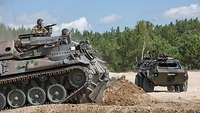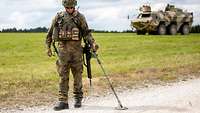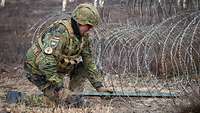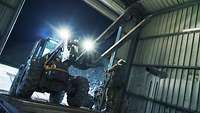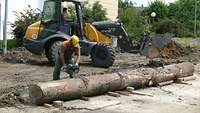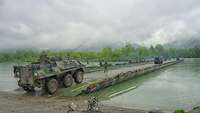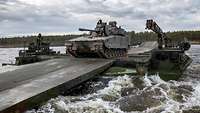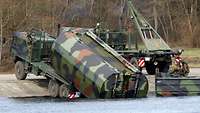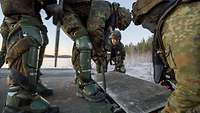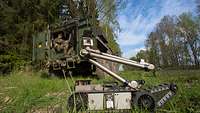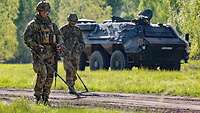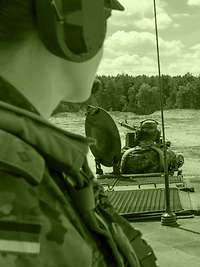
Corps of Engineers
The diversity of the German Army is reflected in its different branches. Each of these branches has its very own set of distinct skills and capabilities, yet they are at their strongest and most successful only when they work together. Specialised equipment is used to overcome a wide variety of challenges.
Our mission
The engineers are part of the combat support forces of the German Army.
Being an engineer means braving the unknown, courageously tackling the new, taking point in situations in which the way ahead demands a keen eye for the feasible, boldness and hands-on proficiency.
The Army Corps of Engineers has a personnel strength of around 6,200 active-duty soldiers.
The engineers support friendly forces during operations at home and abroad, providing soldiers trained for construction work and technical operations as well as special vehicles, machinery, equipment and tools. The branch is headed by the Director, Corps of Engineers, who is also the Commandant of the Engineer Training Centre and Army School of Construction Engineering, the central training facility for all Bundeswehr engineers.
Mobility and countermobility operations
The purpose of mobility operations on land is to maintain or enhance tactical mobility. The Corps of Engineers facilitates friendly movements when crossing and breaching barriers and obstacles. Its soldiers breach minefields, clear explosive ordnance, remove debris and barricades after destruction due to war or natural disasters, and build march routes and bridges. To do their jobs, engineers employ mine-clearing tanks, explosive ordnance disposal equipment, armoured engineer vehicles, different types of bridging equipment, construction machinery and a variety of special tools.
Engineers also impede and canalise movements of military adversaries. The Corps of Engineers can render important terrain sections, roads and bridges temporarily or permanently impassable. Using armoured engineer vehicles, antitank mines and explosives, engineers can block important terrain sections, roads and bridges.
Identifying and eliminating hazards
Engineers are trained to search for and identify mines, improvised explosive devices and ordnance on land and in inland waters. Specially trained soldiers of the Corps of Engineers and engineer divers can neutralise or clear identified hazards.
The Corps of Engineers uses various types of special equipment to detect and clear mines and improvised explosive devices, such as remote-controlled reconnaissance vehicles and remote-controlled manipulator vehicles, special explosives and a variety of special tools. The Corps of Engineers also includes dogs specially trained to detect mines and explosive ordnance.
Increasing survivability
Engineer forces improve force protection, thus increasing survivability for friendly forces. In urban terrain, engineers repair infrastructure and carry out construction work to reinforce and fortify facilities used for military purposes. In undeveloped terrain, engineers build field fortifications and other types of cover to protect soldiers and military vehicles against direct and indirect fires, individual attackers, and direct attacks.
With their wide variety of skills and equipment, engineers are particularly capable of overcoming the special challenges inherent in modern, usually multinational operations. Engineers have proven their mettle on numerous operations abroad.
The Army Corps of Engineers
Passen Sie jetzt Ihre Datenschutzeinstellungen an, um dieses Video zu sehen
How engineers fight

Anker – Wirf! [Anchor away!]
Our equipment
In addition to the extensive technical training that engineers receive, such as in the fields of explosives, ordnance or construction engineering, they also employ machinery and equipment to accomplish their missions.
One of the most well-known items of engineering equipment is probably the Dachs armoured engineer vehicle. It has proved its worth on numerous occasions in emergency and disaster relief operations as well as on operations abroad.
The Dachs armoured engineer vehicle: A true jack-of-all-trades
Thanks to its versatility, the Dachs armoured engineer vehicle is the ace up the engineer’s sleeve. It can recover damaged vehicles, create access to and from waterway crossing sites, and emplace and remove obstacles and barriers on the battlefield. Electric cutting and welding equipment, a crane jib and a cable winch for loads of up to 70 tonnes make the Dachs the all-purpose tool of the Corps of Engineers. With additional equipment, this armoured engineer vehicle can even be used in up to four metres of water.
In addition, the Corps of Engineers has special vehicles that enable water crossing. With the armoured bridge-laying vehicles Biber and Leguan or the M3 amphibious bridging vehicle, engineers are capable of quickly crossing terrain gaps and bodies of water.
The Keiler armoured mine-clearing vehicle along with remote-controlled manipulator vehicles with a variety of add-on equipment are used to clear mines and explosive ordnance. Using mine layers, engineers can also emplace minefields. In addition to these vehicles, however, the Corps of Engineers also employs a wide range of commercial construction machinery and tool kits used, for example, to build roads, bridges and field fortifications.
Our history
History of the Corps of Engineers.
The Bundeswehr’s combat engineers, also known as Pioniere, developed from three historical predecessors: the Sappeur (who built trenches and other types of cover), the Mineur (who handled explosives and mines) and the Pontonier (who built bridges).
The armies of ancient Rome already had specialized soldiers, skilled craftsmen known as fabri. The first engineers, by today’s standards, were trained and employed as entrenchment builders in France and Germany from around 1500. In the Prussian Army, the term Pionier , or pioneer, first appeared in the Regiment Pionniers. By royal decree, this regiment was formed on 8 January 1742 by General Gerhard Cornelius von Walrawe, King Frederick the Great’s master military architect.
The term Pionier in its modern military sense of combat engineer was used for the first time in 1810. At the suggestion of General Gerhard von Scharnhorst, the already existing Mineur and Pontonier companies were combined to form a corps of pioneers, or combat engineers. Due to the rapid pace of technological development, engineering equipment was continuously updated. At the same time, the personnel strength of the combat engineer force continued to increase, and from 1860, it had its own combat engineer battalions and colours.
During the grinding trench warfare on all fronts of World War I, the combat engineer force gained immense importance. Due to an enormous requirement for specialised support in all types of combat operations, a large variety of special engineer units were established: construction and bridging engineers, railway engineers, “mine launcher” or mortar engineers, assault engineers, trench-builder engineers, and battalions that built or improved military works, roads and other infrastructure. Other engineer units deployed chemical weapons and flamethrowers.
From 1921, after the end of World War I and as a result of the Treaty of Versailles, the combat engineers were considerably reduced in strength until the Reichswehr was disbanded. Railway troops and flamethrowers were forbidden altogether. From 1935, however, with the establishment of the Wehrmacht, the personnel strength of the combat engineer force was again increased. The railway engineers, which had been prohibited, were re-established. Additionally, efforts were made to motorise the combat engineer force.
The outbreak of World War II considerably accelerated technological progress in the development of engineer explosive ordnance and engineer equipment. The combat engineer force was once again expanded and further specialised. In addition to traditional engineering tasks, combat engineers were also employed on all fronts as assault engineers providing immediate support to the infantry. Airborne engineers were formed to support the paratroopers. As an important condition for Army logistic support, railway engineers expanded the rail network in the conquered territories. Construction and fortification engineers helped build the Atlantic Wall and the Siegfried Line and were also employed for national and coastal defence. In 1944, around 600 engineer battalions existed. After Germany surrendered in 1945, the combat engineers, as part of the Wehrmacht, were completely disbanded.
With the establishment of the Bundeswehr in 1955, a new Corps of Engineers was set up as well.
Technological progress made in the years following the Second World War was of major importance for the development and introduction of weapons and equipment. For the first time, special engineers were employed to build and maintain pipeline systems to provide fuel to the armed forces. During the Cold War, a strong Corps of Engineers was developed. It consisted of active-duty soldiers of the Field Army under NATO command as well as of active-duty soldiers and reservists of the national Territorial Army.
The 1962 flood disaster of Hamburg was the first major test for the Bundeswehr and particularly the Corps of Engineers. With their assault and inflatable boats, the engineers saved many lives. Numerous other relief operations at home and abroad followed. Using their heavy equipment, engineer forces proved their worth, such as in 1976 and 1980 during the earthquake relief efforts in Italy, in 1978 during wildfires in the Lüneburg Heath, and in 1979 during the snow disaster in Schleswig-Holstein.
In the early nineties, German reunification and the end of the East-West conflict brought formidable structural change to the Corps of Engineers. The Field and Territorial Armies were combined, and the Corps of Engineers was adapted to requirements and scaled down. Current engineering capabilities were tailored to stability operations. For many years, the focus was on operations in the Balkans and in Afghanistan. Since 2016, the focus is once again being placed on national and collective defence.


